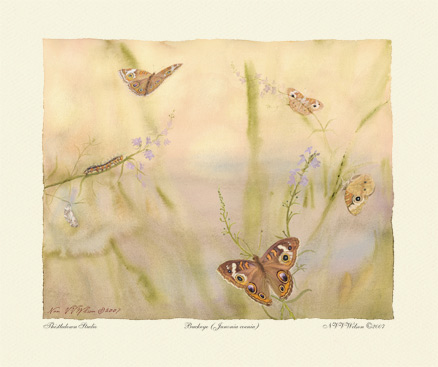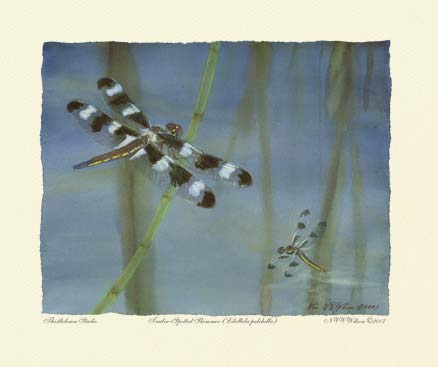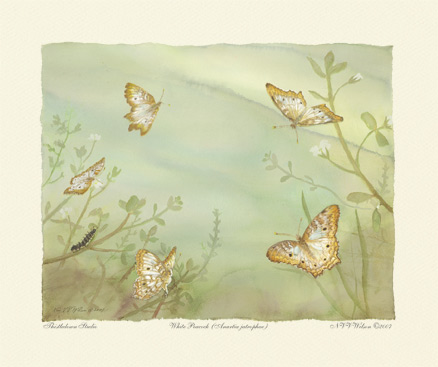news | new works | making of a life cycle painting | newsletter
New
Works
My aim is to attract people to natural subjects
through my art, and to share interesting information
about both the creatures and the host plants that sustain
them.
Each of these
originals is a new watercolor done on 16 x 20 inch arches
paper. Below these images are examples of the information
provided on the labels of all my works.
COMMON BUCKEYE (Junonia coenia)

A migratory butterfly,it favors southern regions but
is seen across most of the
US. In summer adults move northward sometimes reaching
southern Canada. Its larval food plant is toadflax,
plaintains, snapdragons
and others. Large southward movements can be seen in
the fall,
especially on the east coast. Its can be seen in gardens,
open fields
and along roadsides. with a wingspan of 5-6 inches, this
silk moth is large and declining in population. Its
caterpillar is parasitized by a tachnid fly. Food plant
of the caterpillar are trees and shrubs such as cherry,
apple, ashes, beeches, birches, elms, maples and poplars.
The cocoon is spindle shaped and attached to an exposed
branch in a tree. Also found on the ground on loose
leaves. It flies from May to June with one brood. Increasingly
common in urban and suburban areas.
TWELVE-SPOTTED SKIMMER (Libellula pulchella)

A wingspan of two inches, this dragonfly perches on
shoreline vegetation. The female lacks the white patches.
Males are territorial and perform
vertical loops with competing males. They inhabit ponds,
lakes and
sluggish backwaters, occasionally bogs and alkaline
wetlands. They
can be found throughout the USA. This is a small to medium
dragonfly 1.0 to 1.7 inches in length. During maturation
the abdomen and dorsal area turns primrose blue, about
nine days for males, slower in females. Outer half of
each wing can be tinted brown. Females have interrupted
yellow stripes on abdomen. Found in most still waters
and commonly found throughout. Found in mid-June to
September in the north USA and Ontario, Canada. They
perch with lowered wings on erect stems. Much territorial
action flying under opponent and forcing out of area
of water. Has been seen migrating in small numbers.
WHITE PEACOCK (Anartia jatrophae)

This is a tropical brushfoot, common in Florida and
South Texas, straying northward.
It can be seen along roadsides, fields, and gardens. The
larval food plants are water hyssop, green shrimp plant, frogfruit
and others. |